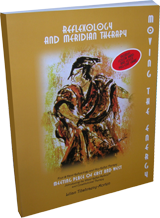Moving the Energy: Reflexology and Meridian Therapy
Click for larger Image
$36.00 (shipping in the U.S. $5)
Lilian Tibshraeny-Morten: Teacher of Reflexology for the past 23 years and the 12 Meridians and 5 Elements for the past 14 years. was born and raised in Pretoria, South Africa. Lilian's stepfather was a leading pathologist, the first to start a privately owned laboratory in Pretoria. Her work with him encouraged her to pursue a career in the medical field. In 1970, she graduated from the College of Occupational Therapy in Pretoria. Through the years she continued to study reflexology, acupuncture, kinesiology and massage therapy. In 1982, Lilian started her studies in reflexology under Dwight Byers, the President of the International Institute of Reflexology (I.I.R.). Lilian became certified through the I.I.R. in 1983. In 1986, she became the South African Director for I.I.R. and maintained that position for twelve years. During that time, Lilian founded the International Institute of Reflexology Association, South Africa. She also served on various boards involved in the recognition and legalization process of establishing reflexology as a profession in South Africa.
In the same time period, Lilian taught all over the world with Dwight Byers. In 1998, he invited her to assume the position of Director of Education at his home office in St. Petersburg, Florida. He facilitated her emigration process to the USA and she maintained that position until December 2001. Lilian was able to complete her training at the Acupuncture Training Institute of South Africa in 1994. She studied at the China Beijing International Training Center. She also gained valuable experience with additional training under the doctors at the Beijing Acupuncture Hospital. The dual training in both Acupuncture and Reflexology enabled Lilian to develop an intensive training program incorporating the vital components of the Twelve Meridians, Five Elements and Reflexology. In 2002, Lilian trained at the Humanities Center in Florida where she became a Licensed Massage Therapist and passed the National Certification Board examination. In 2002, Lilian and her husband, James Morten, established the company JLM PUBLISHING®. Through this company Lilian has been able to create educational manuals, reference guides and workshops. She has traveled extensively in America, England, Scotland and South Africa teaching her approach to therapeutic work. Lilian has been invited to be a Keynote Speaker at several conferences in the United States and South Africa. At the present time, Lilian is a professional Reflexology practitioner certified through the American> Reflexology Certification Board (ARCB). She has attained her teacher accreditation through the American Commission for Accreditation of Reflexology Education and Training (ACARET). She has served on the ACARET board for two years and at present holds the office of president.
Sherry Fears -
Reflexology and meridian therapy are two complex subject matters. Lilian Morten has written a text that all students will appreciate because she has taken the time to develop multiple reinforcement approaches for each new content she presents. With charts, tables, color-coding, visual aids, integrated symbols, and description text, this book will be a "keeper" for all those interested in a text that integrates information in a new and exciting approach to therapeutic assessment and application. For learners who have difficulties with processing information (learning disabilities), this book may be just what you have been looking for because Lilian is particularly sensitive to those who deal with this issue. The illustrations and diagrams are wonderful, the art work is great, and the fold-out visual aids can be used right in your office! Very reasonably priced for the amount of information and depth of learning possible through this book.
Dear Lil,
Thanks so much for your amazing book. It must have taken years to put together and is a testimony to your passion, your gift for healing, your experience and knowledge of your subject and dedication. We have been spending, as lay people, much time in getting acquainted with the contents and keep being knocked out by the cross referencing and detail. It will no doubt become the "Bible", not just for reflexology but for the other therapies which are so diligently covered. Lil may you go from strength to strength and enjoy your success - you deserve it!
- Steven and Yvonne Klagsbrun
Without a doubt, Lilian Tibshraeny-Morten’s book brings the Eastern meridian theory and the Western approach to reflexology in a fantastic, easy and understandable way.
Lilian’s au courant illustrations and overall book content show that she has done her homework. Her many years of dedication to teaching, research, and practical experience affords her the title of “Dreadnought” in this field.
I have been teaching the Ingham Method® for over 60 years and I find this book is one of the best reference guides I can have at my fingertips, because sometimes we all forget how important it is to explore all these avenues of success.
This book will become the professionals’ guide to Meridian Therapy. These therapeutic points are like having additional reflex points which are advantageous to the therapist in achieving faster results and ultimate health for their clients.
I can’t say how proud I am of Lilian and this faboulous book. Lilian is to be commended for her outstanding dedication to improving the knowledge and skills of the professional therapist. My sincere congratulations to Lilian for completing this book. It is one which every therapist should acquire for their library.
Dwight C. Byers
President and Founder
International Institute of Reflexology
St Petersburg, Florida. USA
I hope this text book will inspire students to explore the various aspects of this vast subject in greater detail. The purpose of writing this book was to combine two passions of mine, reflexology and acupuncture. This book is designed to serve as a reference guide for information when it is relevant to the situation.
The use of symbols, graphic summaries and specific colors makes it easy to find the relevant information without having to read the entire text. This method of learning is very dear to my heart. As a child, I suffered from dyslexia and perceptual problems which made learning very difficult.
I was always the “stupid” one, who struggled to read. In those days this particular disorder was not recognized as a disorder, but was regarded as stupidity or laziness. As a teenager I realized that I was not stupid, but I had a problem and I figured out how to counteract it. Later, when I studied Occupational Therapy I learned that the problem was called dyslexia. So I was determined to make learning from this book simple and I wanted to use as many visual aides as possible.
As a young adult, reflexology was my first passion. I studied every book and worked on every foot I could lay my hands on. After about eight years in the field, I came across a problem that had me stumped. This involved a young man who suffered from tinnitus so severely that he had to sleep with a radio on in order to block out the “waterfall” which was perpetually there. This condition had already plagued him for two years.
I treated him for several months via reflexology. No result was forthcoming. About that time I started my training in acupuncture, and a whole new world opened up for me and my practice. I realized that the ear reflex was only the site of his problem and not the source of his problem.
I examined the organ reflexes that may be responsible for the tinnitus according to the acupuncture theory. These organs are the liver, kidney, and/or small intestine. I had been reflexing these areas, but had not come across anything unusual. This is when I decided to try to work these reflexes with a wand. The wand is shaped like a very fat, short pencil, one side is narrow and the other side is broader. It is made from selenite. his liver and kidney reflexes showed nothing unusual. However, the small intestine reflex was different. There was a pinpoint spot that was extremely painful for my client. I continued to work this tiny spot with the wand. The young man said that when that spot was worked he felt a direct connection into his ear. The “WAND REFLEX™” was worked several times during the session. The client returned to work. Two hours later he phoned me to say that the “waterfall” noise was finally silent. With weekly treatments we managed to keep the condition at bay. That is how I discovered the “WAND REFLEX™”. This incident made me realize just how powerful a treatment could be when the acupuncture theory was applied to reflexology.
The first book I read on Chinese Medicine was written by Dr. Ted J. Kaptchuk. It is called The Web That Has No Weaver, which inspired me to study acupuncture. Thank you, Dr. Kaptchuk. I do not claim that the information contained in this book is original. It is not. The information herein is a combination of many resources.
However, the concept of the “WAND REFLEX™” emerged through trial and error in my own reflexology practice. It is my hope that the reader will find this text book both informative and fun to use.
This book has been six years in the making. Every time I thought it was completed, I realized that there was always more important information that could be included in this text. Unfortunately this process could go on forever, so I have finally drawn the line and consider this book finally finished.
Lilian Tibshraeny-Morten
This book introduces a treatment approach called the WAND REFLEX ™ METHOD. Before a practitioner can use this method effectively they must understand both reflexology and meridian therapy. This book is designed to extend the technical and assessment skills of the Body Worker, Reflexologist or Massage Therapist.
This book was written for both students and professional practitioners. It is easy to understand due to the visual style and the use of color and symbols for easy identification of the material.
The first section of the book includes basic reflexology theory, foot and hand techniques, anatomy, physiology and pathology. It gives the reader an in-depth account of the structure of the feet as well as the abnormal biomechanical factors and common foot disorders. It also discusses a basic reflexology treatment protocol.
The second section of the book incorporates basic concepts of Chinese Medicine. These concepts include the Vital Substances and the Chinese perspective of organ function and dysfunction of the Five Elements. Details of the fourteen meridians and the Five Constitutions are also detailed. These include the specific points and interaction between the Five Elements with regard to harmonious relationships, as well as descriptions of disharmonious relationships.
The reader will gain an understanding of diagnosis and assessment according to the Eastern Philosophy: Patterns of disease, constitutional types, basic Tongue, Face and Pulse diagnosis, Midday-Midnight Law, client assessment, client in-take form and case analysis are all presented.
The reader will be exposed to important acupuncture points, accompanied by their functions and indications, emotional points and the treatment protocol for constitutional types.
The third section of the book deals with assessment tools and the WAND REFLEX ™ METHOD of treatment. There is a complete guide to treatment options. These include the identification and application of the Wand Reflex TM. Lilian presents charts, tables, graphic illustrations, diagrams and precise descriptions of specialized techniques. These unique approaches combine Reflexology and Meridian Therapy in a way that facilitates the integration of these treatment protocols into an existing practice.



